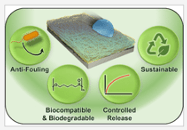UW Madison researchers from the lab of Prof. David Lynn have described a biocompatible antifouling or “slippery” surface made from biodegradeable components (ACS Appl. Mater. Interfaces 2022, 14, 15, 17940–17949). Adhesion of various contaminants (dirt, ice, bacteria, proteins) to surfaces, also known as surface fouling, is a great challenge in many areas. Specific examples range from small annoyances such as spilled food sticking to clothing or your favorite condiment sticking to the inside of its container to areas of greater economic impact such as ice adhering to airplane wings or barnacles to ships. If we think about biological materials, given recent events, everyone would be interested in surfaces that can repel virus particles. Adhesion of proteins or other materials within the body can also greatly shorten the lifetime of various implants or lessen the functionality of tools (blood coating a camera lens).

Considering how broad a set of problems this is, people have tried many different surfaces made with many different materials, all with their own pros and cons. A major problem for various anti-fouling surfaces is that many of them rely on fluorinated materials, which can be toxic. Coatings often complicate end of life for objects, as they can lessen the recyclability or lengthen time in landfill of the underlying object.
One type of solution to the issue of surface fouling are so-called “slippery” surfaces, or liquid infused surfaces. These are surfaces which embed or somehow capture a liquid onto them, giving the solid surface some of the properties of liquids. This allows for dirt or other contaminants to “flow” off of the liquid-solid surface. This strategy has been used to successfully repel water, oils, dirt, proteins, and other unwanted surface contaminants. These surfaces overcome some of the problems associated with superhydrophic surfaces, such as losing effectiveness at low temperatures or under hydrostatic pressure.
Lynn, et al, describe such a slippery surface made from both biocompatible and biodegradeable materials. The surface itself is a mat made from fibers of poly(ε-caprolactone), a hydrophobic and biodegradeable polymer and then various oils such as food oils are infused into this surface. The result is a surface that can repel liquids and other objects such as microbial pathogens. The infused oils can also be used to release a “cargo” such as drugs or an antimicrobial (so long as it is soluble/dispersible in the oil). This surface can be applied to objects of arbitrary shape and size, and the coating is environmentally friendly.